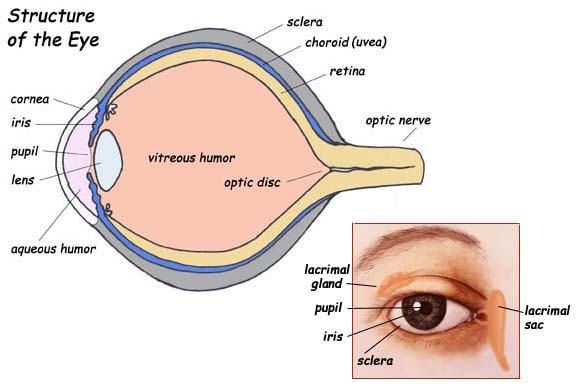

Eyes
Sight is a very useful sense. 70% of all sense receptors are in the eye. There are over a million nerve fibers bringing sight signals to the brain. The adult eyeball is a ball about 1 inch wide. Only a small part of it (1/6th) is even visible. The rest is protected inside the skull and padded with fat. Many organs help with sight.
Eyebrows shade the eyes from sunlight and protect the eyes from dripping sweat. Eyelashes protect the eyes by blinking with lightning speed when something touches them. Eyelids protect the eyes and regular blinking keeps them from getting dried out. Every time you blink, a tiny gland above your eye (lacrimal gland) sends some fluid across the eye to keep it moist. The fluid in the eyes drains out through a sac between them and down into the nose. This is why you get the sniffles when you cry or when your eyes tear from cold wind. Eye muscles move the eyes all around in their socket.
The eyeball itself is hollow, filled with fluid that helps keep its shape. It has 3 layers. The outer layer, the sclera is the white of your eye. In the very center it becomes clear. This part is called the cornea. The middle layer or uvea is what you see in the eye as iris. The opening in the center of the iris is the pupil. The pupil allows light to get into the eye. The iris, made up of tiny muscle fibers, can open the pupil larger in darkness or close it smaller in bright light.
The inner layer of the eye is the retina. The retina has millions of nerve endings, called, "photoreceptors" that receive what we see and send it on to the "optic disc," which sends the message onto the brain through the optic nerve. The optic disc has no photoreceptors of its own, so is the “blind spot" of the eye.
Photoreceptors come in 2 forms. Rods see in dim light and out of the corners of your eyes (peripheral vision). They let you see things in black and white. Cones see in bright sunlight, color, and sharp images.There are 250 million photoreceptors (rods and cones) in the retinas of your eyes.
So, when light enters the eye, it passes through the pupil, through the cornea, lens (which can change shape to focus on things near or far) and through the vitreous fluid in the eye. Then it enters the retina.The rods and cones will then send what they see – the visual stimulus – onto the brain so that you can understand what you are seeing.
Color blindness is when you are missing the cones for either red or green and see them as the same color. Many color-blind people don’t even know they are color blind until they are tested. It is much more common in boys than in girls.
Your eyes can be damaged by too much sunlight. Never look directly into the sun. If you are going to be in the sun for a long time, besides for sunscreen, wear good sunglasses. Make sure they are UV protective sunglasses so they are filtering out the most harmful rays.
Scientists have discovered that people blink less if they are concentrating on an action computer game. Blinking keeps your eyeballs moist, so many hours of not blinking can dry them out. Besides for making your eyes red, this can lead to eye strain and head aches. Take a break, rest your eyes and remember to blink.
